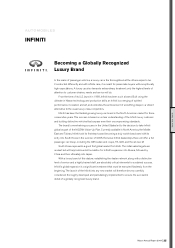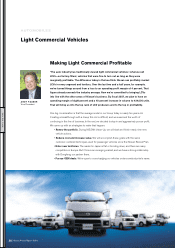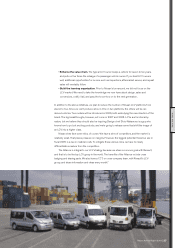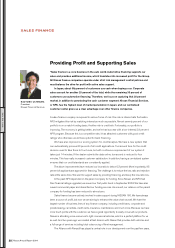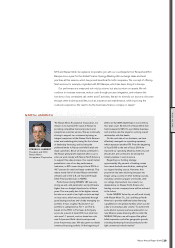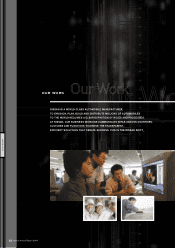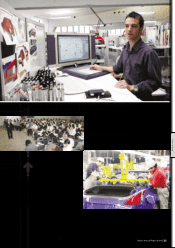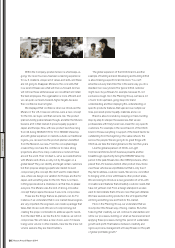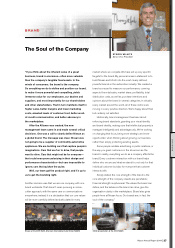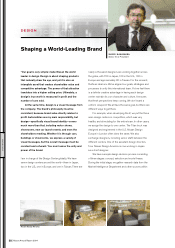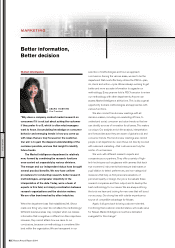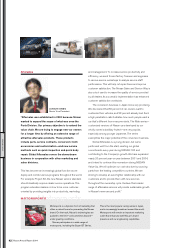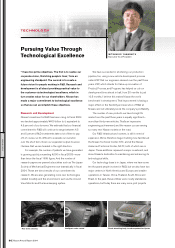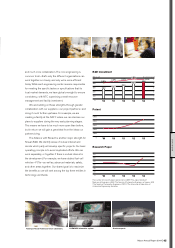Nissan 2005 Annual Report Download - page 37
Download and view the complete annual report
Please find page 37 of the 2005 Nissan annual report below. You can navigate through the pages in the report by either clicking on the pages listed below, or by using the keyword search tool below to find specific information within the annual report.
Nissan Annual Report 2004 35
OUR WORK
10 New
Conquest Models
18 Replacement
Models
28
28
NISSAN 180
New Products
Start of
Production
NISSAN Value-Up
70
70
44
28
28
31
Nre Global Product Launches 28 All-New Models
The Process and Resource Management division is one
of Nissan’s greatest assets. They are sometimes perceived
as too rigid, and it is true that the division has established
quite a number of rules. However, I easily imagine what can
happen to a company without rules. The point, really, is to
keep the structure and provide some freedom when
needed. The core creative divisions can add great value to
a process, such as when they interact with the advanced
engineering team. When the creative people are happy with
what they have developed, however, someone has to
support the complex process of creating added value. That
responsibility belongs to the Process and Resource
Management division. Otherwise, a nicely crafted process
may never be implemented. But at Nissan, employees in the
Process and Resource Management division serve as the
guardians of the timelines and support the implementation
of processes. If a process is not working as we planned,
they get the project back on track in a smooth and efficient
manner. If a process is no longer relevant, they quickly
organize a taskforce to update it.
So Corporate Planning provides the direction, Design
and Product Planning create products with value, and Market
Intelligence and Process and Resource Management
support the creative teams. Someone has to drive the
implementation, and that role belongs to our six program
directors in Program Management. The program directors
are involved from the beginning. They are businesspeople,
the CEOs of their own platform businesses. Each has a
different part of the vehicle lineup, but the substance of their
mutual targets and commitments is simple: profit. Program
directors make it happen. They ensure that everybody in the
Company keeps each project consistently profitable through
all phases: planning, development and launch, right through
to the end of the lifecycle. Our program directors are
persuasive people with strong characters, special skills and
attributes, and they are not afraid to challenge the system.
Their diversity contributes tremendously to Nissan’s
success. The cumulative work of all these divisions results in
a very consistent organization with an upstream process
that creates value.
Looking at Nissan’s global output over the last six years,
it is clear that some terrific products have been created, and
the value of the Company as a whole is greater. There are
many scorecards that reflect this, and our stakeholders
certainly know Nissan’s success first-hand. At the same
time, we must prepare for the future. We need to reinforce
the strength of our program management groups and
establish more precise, accurate groups to standardize and
improve processes for the future. Ironically, our
achievements have created uncertainty for the future.
Success creates risk, and the more we highlight our
successes, the more we raise the anxiety level of investors.
How can our new products be as good as those already
released? How can we keep it all going?
One way to sustain our strong pace is to take greater
advantage of the Alliance. The value is there, in areas such
as purchasing, development, benchmarking, sales networks,
market knowledge and even financial strategy. Yet we must
maintain both a balance and a clear separation between the
brand identities of Renault and Nissan. Neither company
wants to make the same cars, or have the same corporate
culture, or have its brand mistaken for the other. We will
continue to derive benefits from this strategic partnership
while remaining Nissan.


